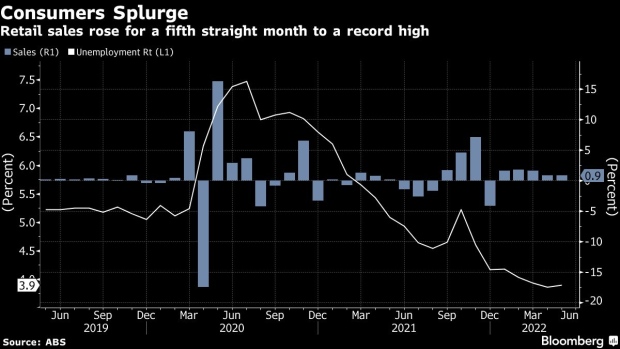Jun 28, 2022
Australian Consumers Spent Big in May After First Rate Hike
, Bloomberg News

(Bloomberg) -- Australian retailers enjoyed a fifth straight month of sales gains in May, suggesting cashed-up households coped well after the first of two interest rate hikes by the central bank.
Sales advanced 0.9% in May, more than double what economists had predicted, to a fresh record A$34.2 billion ($23.6 billion). The jump adds weight to expectations that policymakers will continue on a path of rapid monetary tightening this year.
“So far households have successfully absorbed the impact of rising consumer prices and haven’t been spooked by rising mortgage rates,” said Callam Pickering, an economist at global jobs website Indeed Inc., who previously worked at the central bank. “That would give the Reserve Bank some confidence in the economy’s ability to withstand these turbulent times.”
May’s sales jump was broad-based across five of the six retail industries and was driven by higher prices, the Australian Bureau of Statistics said in a statement Wednesday. Department stores had the largest rise, up 5.1%, followed by cafes, restaurants, and takeaway food services.
The Australian dollar rose after the data, before giving up some of the gains to trade at 69.12 US cents at 12:22 p.m. in Sydney. Benchmark three-year bond yields climbed from their lows of the day to 3.29%.
While the figures will provide some comfort to the RBA, it remains to be seen how its second, larger hike to 0.85% in June affected consumers. The central bank raised borrowing costs by half a percentage point this month and has signaled further hikes to come, leading money markets to price in a rate of about 3.25% by year’s end.
Cloudy Outlook
Pickering and his counterparts at banks expect the RBA to hike the cash rate aggressively over the remainder of this year, including another half-point hike next Tuesday.
Some economists fear consumer spending, which has so far stayed resilient in the face of surging prices and a cooling property market, is due to take a hit. Private consumption accounts for almost 60% of Australia’s A$2.1 trillion annual economic output.
“It may take a few months to see the impact in the retail data as consumers adjust spending,” said Diana Mousina, senior economist at AMP Capital Markets. “Retail spending is likely to slow from here as consumers battle with an increase in interest rates and high inflation.”
(Adds economists’ comments.)
©2022 Bloomberg L.P.





